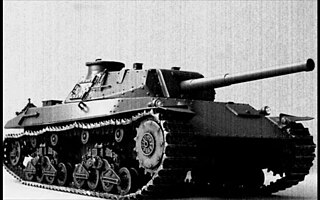
The L6/40 was a light tank used by the Italian army from 1940 through World War II. It was designed by Ansaldo as an export product, and was adopted by the Italian Army when officials learned of the design and expressed interest. It was the main tank employed by the Italian forces fighting on the Eastern Front alongside the L6/40-based Semovente 47/32 self-propelled gun. L6/40s were also used in the North African campaign.

AEC Armoured Car is the name of a series of British heavy armoured cars built by the Associated Equipment Company (AEC) during the Second World War.

Tanks were initially deployed in World War I, engineered to overcome the deadlock of trench warfare. Between the two world wars, tanks were further developed. Although they had demonstrated their battlefield effectiveness, only a few nations had the industrial resources to design and build them. During and after World War I, Britain and France pioneered tank technology, with their models generally serving as a blueprint for other countries. However, this initial advantage would slowly diminish during the 1930s, shifting in favor of the Soviet Union and, to a lesser degree, Nazi Germany.

The P 26/40 was an Italian World War II heavy tank. It was armed with a 75 mm gun and an 8 mm Breda machine gun, plus another optional machine gun in an anti-aircraft mount. Design had started in 1940 but very few had been built by the time Italy signed the armistice with the Allies in September 1943 and the few produced afterwards were used by the Germans.

An artillery tractor, also referred to as a gun tractor, is a specialized heavy-duty form of tractor unit used to tow artillery pieces of varying weights and calibres. It may be wheeled, tracked, or half-tracked.

The Autoblindo 40, 41 and 43 were Italian armoured cars produced by Fiat-Ansaldo and which saw service mainly during World War II. Most autoblinde were armed with a 20 mm Breda 35 autocannon and a coaxial 8 mm machine gun in a turret similar to the one fitted to the Fiat L6/40, and another hull mounted rear-facing 8 mm machine gun.

The Ansaldo 105/25 M43, also known as Semovente 105/25, was an Italian self-propelled gun used during World War II and designed by Ansaldo. It was the most powerful self-propelled gun built by Italy in numbers during World War II.

The Carro Veloce 33 (CV 33) or L3/33 was a tankette originally built in 1933 and used by the Italian Army before and during World War II. It was based on the imported British Carden Loyd tankette. Many CV 33s were retrofitted to meet the specifications of the CV 35 in 1935. In 1938, the CV 33 was renamed the "L3/33" while the CV 35 became the "L3/35s."

The Straussler V-4, also known as Light Tank V4 was a Hungarian amphibious light tank design of the interwar period and it was designed by Nicholas Straussler. It was developed from the V-3, one of Nicholas Straussler's earlier models.
Ansaldo Energia is an Italian engineering company.

The Carro Armato M Celere Sahariano or M16/43 was a prototype medium tank developed by the Kingdom of Italy during World War II to match the speed and firepower of contemporary British cruiser tanks encountered by Italian forces during the Western Desert Campaign. The project was cancelled following the expulsion of Axis forces from North Africa in May 1943. Had it entered service, the tank's designation would likely have been M16/43: "M" for Medio, "16" representing the vehicle's weight in metric tons and "43" being the planned year of introduction.

Tanks have been employed by the military forces in Italy since their first use in World War I. They have had continued use in wars after and are still used through the modern day. The C1 Ariete is the current main battle tank of the Italian Army.

The P.43 Bis was a proposed Italian heavy tank designed in April 1943,. It was created as a direct continuation and replacement P26/40 tank; however there was a prototype at the end of summer 1943.
During the Second World War, the Kingdom of Romania produced, converted or significantly improved a variety of armored fighting vehicles, ranging from licence-built unarmed artillery tractors to tank destroyers of an original design which ended up - according to some accounts - as inspiration for some German AFV.











